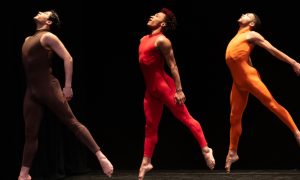April 15 is right around the corner, and many of you may be eyeing that bulging file of receipts with dread – after all, we are dancers, not accountants! To ease your fear of filing, Dance Informa visited Vito Sclafani, owner of Vasco Accounting in New York City.
Nearly all of Sclafani’s clients are dancers and other artists. He is naturally drawn to the art world. He was a photographer before he went to work for Top-Four accounting firm KPMG in 1989; in 1991, he started his own firm. He has also served on the board of art services organization The Field and has lectured regularly on tax preparation there. He has also given presentations at Juilliard and Columbia University.
Here are Sclafani’s five top tips for the days ahead.

Accountant Vito Sclafani in his New York City office. Photo by Joseph Zummo.
#1. Help!
First of all, Sclafani says, if you don’t feel entirely ready to prepare your taxes, you can consider going to a professional and/or filing for an extension via the Internal Revenue Service’s Form 4868. An extension will give you six additional months in which to get organized. “Don’t worry,” says Sclafani. “An extension doesn’t trigger an audit or even raise an eyebrow at the IRS.”
#2. What does — and doesn’t — raise an eyebrow.
Taking deductions won’t trigger an audit either, even if they show you had an overall loss in any given year, according to Sclafani. “If you have a legitimate business, and your expenses are ordinary and necessary, you may deduct them,” he explains.
What can get you in trouble is lumping deductions together, rather than separating them into the proper categories on the IRS form for business deductions, called Schedule C. “The first IRS scrutiny of your return will be via computer,” he says. “If you’ve got big expenses that you didn’t divide into the appropriate categories, the computer may kick out the return for a closer look by an agent.”
Sclafani adds that travel and entertainment expenses are a special concern for the IRS because those are areas some have abused.
#3. Paper trail.
“Receipts, receipts, receipts!” says Sclafani. “I can’t stress enough how important they are. Save everything, even if you’re not sure at the moment that it’s a deductible expense. If you aren’t saving them already, start immediately so you can better document next year’s tax filing.”
Back up receipts with a datebook or journal, noting activities and expenditures. If you have an income-generating activity in addition to dancing, keep its receipts apart and file a separate Schedule C to claim related deductions.
The receipts must be paper copies, not electronic or credit card versions. A credit card receipt may not be detailed enough, Sclafani explains. “It may show that you went to a restaurant but not the number of meals you purchased, helping demonstrate that you were there with someone and discussing business,” he says. “It may show that you went to an electronics store but not that you purchased a video camera to record your dances.”
Many vendors will offer to email your receipt. Ask for a paper one instead, he advises. At tax time, you may not be able to find all your e-receipts, and you may have forgotten details of the purchases, Sclafani notes. Making matters worse, electronic materials are not necessarily saved for long periods by businesses, banks and credit card companies. If you were audited at some time in the future, you might find it difficult, expensive or even impossible to retrieve the information.

Vito Sclafani explains home office deductions to dancer and healing-arts practitioner Emily Anton. Photo by Joseph Zummo.
#4. Cutting your tax bill.
Contributing to a SEP-IRA (or Simplified Employee Pension Individual Retirement Account) is typically a good way to lower the amount of tax you owe, Sclafani points out. If you don’t already have such an account, you have until the day you file to set up one for the prior year. That means you can establish a SEP-IRA to which you make 2015 contributions as late as April 15, 2016 — or October 15, 2016, if you filed for an extension.
Most dancers want to put money into their dance business, not retirement. Sclafani notes, however, that a retirement contribution can mean immediate tax savings — money you can then spend on dance, if you wish. Meanwhile, the SEP-IRA contribution will begin multiplying, making you more comfortable when you eventually put your feet up.
#5. Home and away.
If you have a place at home where you conduct a substantial portion of your business activities, it may qualify as a home office, says Sclafani. For dancers, those activities can include rehearsing or performing, but not necessarily; recordkeeping and other administrative tasks can also be enough to define a home office. That, in turn, may allow you to deduct some of what you spend on rent or mortgage, insurance, utilities and more.
In addition, you may be able to claim business-related travel that takes you away from the home office, including local travel. The taxi you took from your home office to a costume shop to pick up costumes for your performance may be deductible, along with the cash you shelled out to get to classes and rehearsals via public transportation or automobile.
“Don’t be fearful of claiming all the ordinary and necessary expenses for your dance business,” says Sclafani. “If you don’t, you’ll end up paying more taxes than you should.”
By Stephanie Woodard of Dance Informa.
Photo (top): Dancer Emily Anton also has a healing-arts practice, so must file two Schedule Cs with her return, says accountant Vito Sclafani. Photo by Joseph Zummo.















